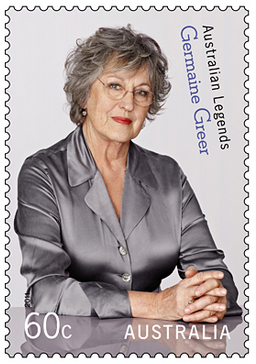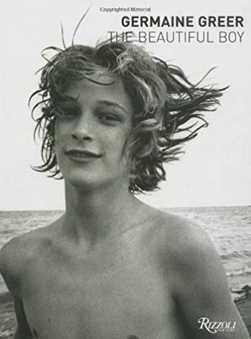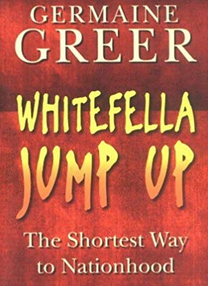GERMAINE Greer at age 30 burnt the Australian flag outside Australia House, London and chanted ‘We are all Viet Cong. We are all Viet Cong!’ That’s as described by fellow expat Richard Neville, who was with her. The Viet Cong at the time were competing with their opponents for worst atrocities, as Max Hastings delineates in his recent book Vietnam.
Being a Left feminist, Greer gets a free pass for just about anything, although she’s pushed the envelope lately by dissing trans people and today’s feminist Zeitgeist.
She gets a few free passes in the new biography Germaine by Elizabeth Kleinhenz, the first to benefit from Greer’s 487-box archive. Greer, who turned 80 last month, sold it to Melbourne University in 2013 for $3 million, less cataloguing and other costs. But Kleinhenz also grits her teeth and spares us little about Greer’s escapades, many or most from Greer’s own pen. Some she found “nauseating”.
 During the Gillard government, Greer graced a postage stamp as an “Australian legend”. That was for allegedly making a significant contribution to the Australian way of life, shaping society for the better, and advancing the equality of women, as Australia Post put it.
During the Gillard government, Greer graced a postage stamp as an “Australian legend”. That was for allegedly making a significant contribution to the Australian way of life, shaping society for the better, and advancing the equality of women, as Australia Post put it.
Her biggest-selling work was The Female Eunuch, a year after the flag-burning. I went along to her National Press Club appearance in Canberra in 1972, intending to query her about the text, but squibbed it – after all we were having lunch. The tract reads [Apologies! Trigger Warning, No Safe Space],
“Women desirous of coming to terms with themselves…might consider their own reaction to the suggestion that they taste their own vaginal secretions on their fingers, or that they taste themselves fresh on the mouth of a lover. Despite my own proselytising attitude, I must confess to a thrill of shock when one of the ladies to whom this book is dedicated told me she had tasted her own menstrual blood on the penis of her lover…”
There are five women dedicatees in Eunuch. Of the first, journalist Lillian Roxon, Greer wrote that she “lives with nobody but a colony of New York [cock]roaches”. That lady was highly offended, maybe doubly so. Greer blamed the lady’s Fairfax New York Bureau’s boss, young Derryn Hinch – “the biggest f***wit of them all” – for paying the journo a starvation wage for his “punishing deadlines” while the SMH “worked her quite literally to death”. But after the funeral Hinch found more than $US60,000 at her bank, half a million in modern money.
Kleinhenz wonders if Greer might be a bit dotty. “Not uncommon in a genius. Like Virginia Woolf and Vincent van Gogh, Germaine Greer is often accused of being at least batty, if not actually barking mad. She evens admits it to herself.” The over-the-top comparison with van Gogh is followed by Kleinhenz’s “Like an eagle, she flies high and free”.
Author Tom Wolfe wrote of a dinner with Greer at London’s toffee Alexander’s in 1969, she with “a tremendous curly electric hairdo”. Greer got bored and set fire to her hair with a match. The waiters had to put out the fire with napkins, making a noise like ‘pigeons taking off in the park’, Wolfe wrote. I think she was lucky to escape the fate of Michael Jackson who was on painkillers for life after sparks on the set ignited his hair.
From that year Greer was on the editorial board and a writer with Amsterdam porn mag Suck. Kleinhenz, despite her strong stomach for Greer-isms, was nauseated reading Suck in the archive. “Almost nothing appears to be off limits,” she writes, including “graphic descriptions of bestiality, incest and abuse of children”.
Suck organised a stage festival at an Amsterdam meditation centre. Greer was a spectator in high-heeled boots and a fur coat bought with early profits from The Female Eunuch. Performer Otto Muehl arrived with a goose. He flourished a glinting knife to cut off its head. His act, as previously, would be to put a condom over the goose’s severed neck and use it as a dildo on a woman previously featuring in a lesbian act. One horrified spectator screamed, “If you kill that goose, we’ll f***ing kill you!” People rushed to attack Muehl, who fell off the stage. They rescued the wildly flapping goose and ran away with it. There was fighting and weeping on all sides. Greer swept to the side of the goose rescuer, “her face radiating gratitude, compassion, even love”, according to witness Richard Neville. Muehl later enjoyed a more conventional art career. The goose lived out its days on an Amsterdam canal barge, Kleinhenz writes.
Greer’s previous biographer Christine Wallace (Untamed Shrew) endorsed a third-party view that Greer is “brilliant, mad, wonderful, poisonous…” and less plausibly, “a great spirit of the age who deserves to be vastly honoured by us and not more than very mildly singed by any of us”.
One who was more than mildly “singed” by Greer, according to Kleinhenz, was Salman Rushdie, from 1989 hiding for his life from Ayatollah Khomenei’s assassins. Two of Rushdie’s collaborators were wounded and one murdered. Staff of his publisher Penguin had to resort to bomb-sniffing dogs and the CEO got death threats on blood-spattered paper.
Greer, says Kleinhenz, had a choice between supporting Rushdie or supporting “the sacred beliefs of our Muslim friends”, and chose the latter. Greer wrote that Rushdie’s book was just about his own troubles, and that he was a dark-skinned English megalomaniac. Rushdie later described Greer as barking mad, an idiot whose “determination to be out of step leads her into batty positions”.
After Rushdie delivered a blast at fans of cultural relativism (who backed the right of “despotic parents to mutilate their daughters”), Greer took the line that female genital mutilation was a facet of other cultures being “perfectly capable of making their own rules to suit their own circumstances”, as Kleinhenz puts it.
She also writes of Greer’s acceptance of some societies’ culling of disabled babies at birth: “Some tribal mothers, Greer noted, ‘bashed their new-borns’ brains out with a rock’ when social and other circumstances warranted.”
Kleinhenz tracks Greer’s celebrity lovers, such as a “wild affair” half a century ago with TV icon Mike Willesee , whose infuriated wife, a Miss Australia, cited Greer as co-respondent. Kleinhenz mentioned this at an author talk last week at my local library, and a gasp arose from the many women present of a certain age. They love Greer, they love Willesee and they couldn’t bear to hear about the nexus, however far in the past. At the time, Greer described Willesee as “a marvellous madman who has Australia conned into thinking that he’s a solid current affairs commentator”.
Greer also occasionally bonked Hollywood star Warren Beatty, but gave him some space when she noticed her pubic lice. “She feared he might not appreciate her in her infested state,” Kleinhenz says, reasonably.
She was staying at the luxury Beverly Wilshire, also favoured by ‘dear Woody Allen’ and Elizabeth Taylor. Kleinhenz: “Having identified the crabs, with the help of a large magnifying mirror, in her eyebrows ‘and goodness knows where else’, she spent the rest of the evening in her sumptuous bathroom, hunting for more until she had discovered ‘two adults, a teenager and assorted eggs’, which she methodically placed in an ashtray.”
She then drove with rocker Frank Zappa and wife Gail in their black Rolls Royce to nearby Schwabs Drugstore, where Zappa commanded the assistant loudly, “Blue lotion, please, for the crabs!’” Kleinhenz suggests, from Greer’s letters, that Greer may have had the crabs earlier and even passed them on to one of her true loves, famed author Martin Amis, to whom she dedicated an unsent 30,000 word love letter, nearly half the length favoured by publishers these days for a novel. The only epigram in it must have been its title, “Long letter to a short love …” since she was nearly six feet tall and Amis was five-foot-four.
What I admire Greer most for is her come-backs. When a disc jockey in 2000 bragged to the BBC that he’d been seduced by Greer in the 1960s, London’s Daily Telegraph asked Greer to respond. She said the sex was so unmemorable she’d forgotten it, but she did remember enjoying a concert with him until he told her he had gonorrhoea. That required her “to run the gauntlet of the ‘Clap Clinic’ the next morning and make some embarrassing phone calls to people she had recently had sex with”. With typical panache she invited any doubters to inspect the blue-card from the Clap Clinic (which showed negative) and a photo of herself and her brief paramour at Albert Hall.
Her biggest-name lover was none other than the filmster Federico Fellini. What he called the ‘insatiable dragon’ in his pants was roused while he checked her out for a role as the giantess in his Casanova. He visited her farmhouse “Pianelli” in his chauffeured blue Mercedes, dismissed the driver and came in carrying an overnight bag with his brown silk pyjamas with cream piping. He had a phobia about bats and one interrupted their cavorting. Greer said his pulse jumped around ‘like a frog in a bucket’. She wondered what she would tell the press if he ‘carked it’ in her bed. She told the Guardian that Fellini during this tryst often phoned his wife, Giulietta, to touch base. Kleinhenz says that was a nice touch but the house had oil lamps and no electricity, let alone a phone.
Greer rejects that she’s lesbian. A feminist friend Jill Johnston reported that Greer had remarked in 1971 that “a black lesbian she knows sometimes gets it off on her”. Greer later acknowledged lesbian relationships but nothing strong and enduring. “What has happened is that on several occasions women have made strong advances to me and I’ve been compelled to respond,” she is quoted in an academic paper.
 At 64, she sailed close to the wind with her book The Beautiful Boy about boys in art, from Cupid to Boy George. She took accusations of paedophilia in her stride, says Kleinhenz. Greer said she wanted women to reclaim the right to appreciate the short-lived beauty of “ravishing pubescent boys” with hairless chests, wide-apart legs and slim waists. Asked on Canadian television to explain the attraction, she replied, “Sperm that runs like tap-water will do.”
At 64, she sailed close to the wind with her book The Beautiful Boy about boys in art, from Cupid to Boy George. She took accusations of paedophilia in her stride, says Kleinhenz. Greer said she wanted women to reclaim the right to appreciate the short-lived beauty of “ravishing pubescent boys” with hairless chests, wide-apart legs and slim waists. Asked on Canadian television to explain the attraction, she replied, “Sperm that runs like tap-water will do.”
Greer’s heartfelt quest in the 1970s to become a mother makes for sad reading. She has written publicly that her reproductive system had been damaged in student days by use of a Graefenberg ring contraceptive. She managed two pregnancies, both unsuccessful. Not long after, she invited a poor and distressed pregnant student of hers at Warwick University to stay at her flat. She adored the baby girl and became a long-term surrogate mother.
In a second episode, she took in to her farmhouse, The Mills, Australian actress Kate Fitzpatrick, who was seven months pregnant, Kleinhenz writes. But the house was unheated and as with other guests, Greer expected Fitzpatrick to earn her keep. This involved tending a frozen cabbage-patch garden, torture for the heavily-pregnant woman. “Most bizarrely of all, Germaine was insisting that the baby be born in her own bedroom at The Mills, rather than in a hospital or in its mother’s room. Without a car, Kate was trapped and Greer refused to let her go. It was only with the aid of sympathetic friends that the frantic actress eventually managed to smuggle herself out.” In case readers are wondering, Kleinhenz draws this from Fitzpatrick’s own memoir.
 I’d like to go into her thesis in Whitefella Jump Up (2003) that we should get Aborigines to teach us how to all become Aboriginal in an Aboriginal Australia, but my piece would then resemble her 30,000-word draft to Martin Amis. I did enjoy this bit: in the 1980s, Kulin women in inner-Melbourne Fitzroy offered to adopt her. “She was taken aback,” says Kleinhenz. “Would she be expected to isolate herself in some remote spot for a month or more and ‘be painted, smoked or cut about?’ she asked herself. But her fears were groundless. ‘That’s it,’ said the Kulin women. ‘It’s done, we’ve adopted you!’” I was surprised they didn’t include a tax invoice.
I’d like to go into her thesis in Whitefella Jump Up (2003) that we should get Aborigines to teach us how to all become Aboriginal in an Aboriginal Australia, but my piece would then resemble her 30,000-word draft to Martin Amis. I did enjoy this bit: in the 1980s, Kulin women in inner-Melbourne Fitzroy offered to adopt her. “She was taken aback,” says Kleinhenz. “Would she be expected to isolate herself in some remote spot for a month or more and ‘be painted, smoked or cut about?’ she asked herself. But her fears were groundless. ‘That’s it,’ said the Kulin women. ‘It’s done, we’ve adopted you!’” I was surprised they didn’t include a tax invoice.
Greer, for all her Leftist pieties, is considered by some to be a political innocent. When she offered her brand to the Labor Party to help Whitlam’s 1977 re-election campaign, the party mandarins gave her a hasty ‘thanks but no thanks’. Her feminist pal Beatrice Faust once said Greer didn’t have a political bone in her body, except maybe between her ears.
Kleinhenz got no cooperation from Greer for the biography and a bit of trash talk came back. Greer had called prior biographer Christine Wallace a ‘parasite’, ‘dung beetle’ and ‘brain-dead hack’ and threatened to ‘kneecap’ her if she talked to Greer’s mother. Would-be biographer Hazel Rowley was frightened off altogether. Once at Melbourne University library Kleinhenz found herself in the lift with Greer but was too nervous even to say hello.
For comprehensive revelations, this biography will be hard to beat, especially as the worst are from Greer’s own pen. Good job, Liz.
Tony Thomas’s new book The West: An Insider’s Tales – a romping reporter in Perth’s innocent ‘60s is available from the Royal Western Australian Historical Society, Boffin Books Perth and on-line here.
 Sign In
Sign In 0 Items (
0 Items ( Search
Search










Thanks Tony for providing such a positive role model for the modern young ladies.
Alistair – ouch. Scarily, what’ve we got locally that is better?
I’ve always admired GG; though I didn’t ever read her books, I’ve always thought she’d be a great dinner party guest. Dr. Greer must have alienated more people than Kevin Rudd – and that’s saying something.
After all, she just needed love and attention and it becomes painfully obvious she never got it!! Not everybody’s seeming success is a happy story.
Whatever her peccadilloes, Germaine Greer has redeemed herself in my opinion by her current strong stance against the idiocy of militant transgenderism.
DT; to some degree I share your comment on redemption, but she’s obviously emotionally unstable – as are a lot of clever people. Putting it in a psychological frame; she has always behaved as though she assumed log ago that nobody liked her.
And that awful, awful Kate Fitzpatrick….I was glad to read she had been locked up in Germaine’s house; somebody had to!!!!!!!!!
The stamp wasn’t worth a lick!